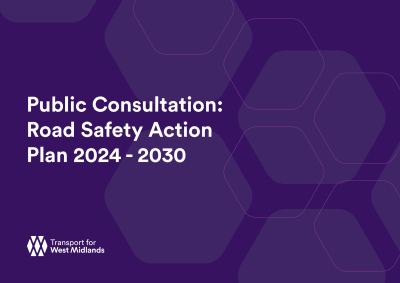Home
Road Safety Action Plan survey
Introduction
Public Consultation: Road Safety Action Plan 2024-2030
What we’re doing
We will be updating our Road Safety Action Plan this year. The document will set out the actions we plan to take as a region to halve road deaths and serious injuries by 2030.
Our actions will be developed following the principles of the Safe System approach:
- People make mistakes
- Humans are vulnerable to injury
- Death and serious injury is unacceptable
- Responsibility is shared by all road users
- We must be proactive, not reactive
- Effective actions are systemic.
As you complete the survey, you will find information on the different aspects of the Safe System and the types of action we could implement.
More information is available in our consultation document (see below).
Providing your comments
We would like to hear your views on how we could improve road safety across the region. Please complete the survey on the next few pages. Your answers will influence the types of measure we include in the action plan.
The consultation will be open until 5pm on Friday 10 May.
Survey for organisations
If you are completing the survey on behalf of an organisation or group, please complete our survey for organisations.
More information
For any questions related to the consultation please email roadsafety@tfwm.org.uk or call 0345 303 6760.
Read our consultation document

Safe Speeds
Information about Safe Speeds
Excessive or inappropriate vehicle speed is the biggest factor affecting the severity of injury in a collision. Even small changes in vehicle speed can have a huge impact on the effectiveness of road safety measures. Research shows that a 5% increase in speed often leads to a 10% increase in the number of injury crashes, and a 20% increase in the number of fatal crashes.
Below are some of the measures that could improve compliance with speed limits.
Expanding enforcement
- Expand the regional average speed camera scheme.
- Restart the static spot speed cameras to address high speed violations.
- Expand the National Community Speedwatch programme. The programme sees residents work with police to monitor vehicle speeds in local neighbourhoods.
Creating a self-enforcing road environment
- Add traffic calming measures, such as chicanes, bollards, speed humps and planters.
- Widen pavements.
- Reduce carriageway width.
Doing annual reviews of speed limit compliance
- Use data to identify areas with low compliance.
- Identify locations with high-speed violations.
- Use data to target locations where speeds are inappropriate for the road design.
- Expand the data available to the partnership through telematics and other technologies.
| Strongly agree | Agree | Somewhat agree | Neutral | Somewhat disagree | Disagree | Strongly disagree | Unsure | |
| Expanding enforcement | ||||||||
| Creating a self-enforcing environment | ||||||||
| Doing annual reviews of speed limit compliance |

Scroll horizontally to see all options
Safe Vehicles
Information about Safe Vehicles
In a Safe System, vehicles must be properly maintained and meet standards. This is to reduce conflicts with other road users, particularly vulnerable road users such as pedestrians, cyclists and motorcyclists. To achieve this, we could reduce the number of unroadworthy vehicles on the road by working with fleet operators, manufacturers and central government to ensure suitable technologies are more widely used.
Technologies such as seat belts, air bags and collision avoidance sensors have meant that motor vehicles have become much safer. However, despite the introduction of more advanced vehicle safety measures, the number of people in vehicles experiencing fatal and serious injuries has increased by 7% in 2022, compared with 2015-2017 casualty data.
Below are some of the measures that could be used to improve vehicle safety.
Removing unsafe vehicles from roads
- Continue the existing multi-agency scheme that seizes and removes non-roadworthy vehicles and those that do not have a valid MOT from our road network.
Providing advice and guidance to consumers about the safety benefits of purchasing vehicles with modern technologies
- Promote the results of the Euro New Car Assessment crash testing programme. This establishes a safety rating for vehicle occupants and vulnerable road users involved in a collision with a vehicle.
- Encourage the use of telematics technology in vehicles driven by young and novice drivers to promote safer driving and assist in reducing insurance premiums.
- Work with vehicle manufacturers and Government to advocate new and emerging vehicle technologies in commercial vehicle fleets, such as intelligent speed assistance.
Work with food and takeaway delivery drivers and riders to ensure that vehicles meet a minimum standard of safety
- Develop an industry-based Road Safety Charter for all e-mobility and motor vehicle delivery drivers and riders.
Raise standards of buses and Heavy Goods Vehicles (HGVs) operating on our roads
- Develop and implement regulations specifying minimum safety requirements for buses and heavy goods vehicles operating within the region.
| Strongly agree | Agree | Somewhat agree | Neutral | Somewhat disagree | Disagree | Strongly disagree | Unsure | |
| Removing unsafe vehicles from roads | ||||||||
| Providing advice and guidance to consumers about the safety benefits of purchasing vehicles with modern technologies | ||||||||
| Working with food and takeaway delivery drivers and riders to ensure that vehicles meet a minimum standard of safety | ||||||||
| Raising standards of buses and Heavy Goods Vehicles (HGVs) operating on our roads |

Scroll horizontally to see all options
Safe Roads and Roadsides
Information about Safe Road and Roadsides
The way that roads are designed has an impact on safety and encourages road users to lead healthy and active lives. Design can improve safety and liveability by reducing the impact and presence of motor vehicles and increasing cycling and walking through lowering traffic in neighbourhoods.
The focus for Safe Roads and Roadsides is to implement a proactive approach to identifying risk, creating a safe and forgiving road environment. An environment that recognises that people will make mistakes.
Below are some of the measures that could be used to improve roads and roadside safety.
Collecting data to identify additional actions relating to safe roads and roadsides
- Assess existing road design and the presence or lack of proven safety features to establish a safety rating to guide future road safety engineering schemes.
- Use near-miss technology to identify high levels of risk for vulnerable road users.
- Undertake travel demand studies around schools and places of worship to better understand traffic management and safety issues.
Making enhancements to existing roads
- Implement advanced stop lines at signalised junctions (for example, traffic lights) to increase cyclist safety during all refurbishment, maintenance and other works.
- Produce guidance for highway scheme designers to ensure safety is at the core of future highway measures.
Improving the road environment for all road users
- Consider implications of all highway safety interventions on public health.
- Explore implementation of evidence-based measures on the road network to assist in increasing safety for motorcyclists.
- Install state-of-the-art technology that increases safety for pedestrians and cyclists of all ages at designated crossing locations.
- Implement recommendations from future travel demand and road assessment studies.
- Monitor and implement changes in legislation, including regulation around the use of e-scooters and civil enforcement of illegal pavement parking.
| Strongly agree | Agree | Somewhat agree | Neutral | Somewhat disagree | Disagree | Strongly disagree | Unsure | |
| Collecting data to identify additional actions relating to safe roads and roadsides | ||||||||
| Making enhancements to existing roads | ||||||||
| Improving the road environment for all road users |

Scroll horizontally to see all options
Safe Road Use
Information about Safe Road Use
While the Safe System approach to road safety accepts that people will make mistakes, the impact of these errors can be minimised through positive road use. These include driving within posted speed limits, watching out for vulnerable road users, and reducing distractions (for example, mobile phone use).
Designers and those who manage our roads play a vital role in developing, implementing and operating a safe road environment. Equally, the role of road users is critical in collectively supporting the mission to eliminate deaths and serious injuries.
Below are some of the measures that could be used to increase safe road use.
Increasing evidence-based education and behaviour change campaigns
- Expand school and community outreach programmes, delivering messages affecting vulnerable road users.
- Publish criminal justice outcomes of life-changing or life-threatening road traffic collisions that proceed to prosecution.
Encouraging greater use of in-vehicle technology to promote safe driving behaviours among young and novice drivers
- Encourage and expand the use of black boxes (telematics) among young and novice drivers.
Enhancing engagement with residents and community groups
- Establish a network of Community Champions.
- Work directly with community groups to develop behaviour change campaigns.
Broadening delivery of national standard cyclist training for children and adults
- Increase the delivery of cyclist training to those statistically most at-risk of death or serious injury on our roads.
- Broaden the delivery of cyclist training to children of all ages.
Deterring dangerous and anti-social driving
- Expand the existing multi-agency road safety enforcement and education operations. Increasing the use of rehabilitation training for offenders
- Introduce the National Driver Offenders Retraining Scheme (RiDE) for motorcyclists.
Enhancing accredited training for those using motorcycles
- Support the motorcycle industry and advocacy groups to review and improve motorcycle licensing and accredited training for motorcyclists.
| Strongly agree | Agree | Somewhat agree | Neutral | Somewhat disagree | Disagree | Strongly disagree | Unsure | |
| Increasing evidence-based education and behaviour change campaigns | ||||||||
| Encouraging greater use of in-vehicle technology to promote safe driving behaviours among young and novice drivers | ||||||||
| Enhancing engagement with residents and community groups | ||||||||
| Broadening the delivery of national standard cyclist training for children and adults | ||||||||
| Deterring dangerous and anti-social driving | ||||||||
| Increasing the use of rehabilitation training for offenders | ||||||||
| Enhancing the accredited training for those using motorcycles |

Scroll horizontally to see all options
Post-crash Care
Information about Post-crash Care
Effective emergency care is at the heart of post-crash response. It can make the difference between survival and death and can prevent injuries becoming permanent and life changing. Protocols to ensure effective coordination of all emergency services are vital to effective emergency medical care, incident management and investigation.
An important component of the post-crash care work is providing support for people bereaved or seriously injured in road crashes. Support can include opportunities to talk to others who have survived a similar loss, building resilience to deal with grief, and guidance on police investigations and court proceedings.
Below are some of the measures that could be used to improve post-crash care.
Supporting charity-based bereavement services
- Promote existing bereavement services delivered by RoadPeace (a national charity for road crash victims) and provide online signposts to these services where appropriate.
Enhancing post-collision education and behaviour change campaigns
- Draw on the experiences of victims and those impacted to support behaviour change and post-collision learning and consider how these might support wider communications and education.
Signposting to post-collision support services
- Signpost victims of collisions to the most appropriate restorative justice and post-collision support services.
| Strongly agree | Agree | Somewhat agree | Neutral | Somewhat disagree | Disagree | Strongly disagree | Unsure | |
| Supporting charity-based bereavement services | ||||||||
| Enhancing post-collision education and behaviour change campaigns | ||||||||
| Signposting to post-collision support services |

Scroll horizontally to see all options
